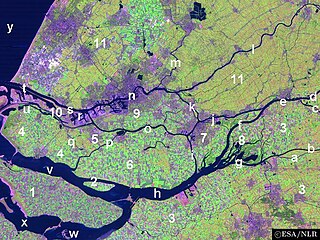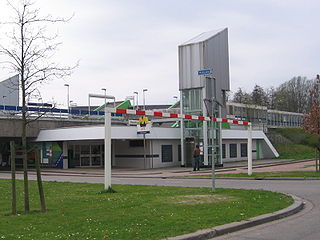
The flag of Suriname was legally adopted on 25 November 1975, upon the independence of Suriname from the Netherlands.

Albrandswaard is a municipality in the western Netherlands, in the province of South Holland. The municipality had a population of 25,814 as of 2021, and covers an area of 23.76 km2 (9.17 sq mi) of which 2.07 km2 (0.80 sq mi) is water.

The Spui is a small tidal river in South Holland in the Netherlands, connecting the river Oude Maas and the Haringvliet estuary, separating the islands of Voorne-Putten and Hoeksche Waard. Historically, it forked off the Oude Maas at the town of Oud-Beijerland to end in the Haringvliet, but as a (planned) result from the Delta Works, its flow has been reversed. The Spui emerged as a result of a levee breach during the All Saints' Flood of 1532, a storm surge that permanently altered the surrounding landscape.

Since 1 January 2023, there have been 342 regular municipalities and three special municipalities in the Netherlands. The latter is the status of three of the six island territories that make up the Dutch Caribbean. Municipalities are the second-level administrative division, or public bodies, in the Netherlands and are subdivisions of their respective provinces. Their duties are delegated to them by the central government and they are ruled by a municipal council that is elected every four years. Municipal mergers have reduced the total number of municipalities by two-thirds since the first official boundaries were created in the mid 19th century. Municipalities themselves are informally subdivided into districts and neighbourhoods for administrative and statistical purposes.

The coat of arms of the Kingdom of the Netherlands was originally adopted in 1815 and later modified in 1907. The arms are a composite of the arms of the former Dutch Republic and the arms of the House of Nassau, it features a checkered shield with a lion grasping a sword in one hand and a bundle of arrows in the other and is the heraldic symbol of the monarch and the country. The monarch uses a version of the arms with a mantle while the government of the Netherlands uses a smaller version without the mantle (cloak) or the pavilion, sometimes only the shield and crown are used. The components of the coats of arms were regulated by Queen Wilhelmina in a royal decree of 10 July 1907, affirmed by Queen Juliana in a royal decree of 23 April 1980.

Rhoon is a village that borders the municipality of the city of Rotterdam, South Holland, the Netherlands.

The national emblem of Indonesia is called Garuda Pancasila. The main part is the Garuda with a heraldic shield on its chest and a scroll gripped by its legs. The shield's five emblems represent Pancasila, the five principles of Indonesia's national ideology. The Garuda claws gripping a white ribbon scroll inscribed with the national motto Bhinneka Tunggal Ika written in black text, which can be loosely translated as "Unity in Diversity". Garuda Pancasila was designed by Sultan Hamid II from Pontianak, supervised by Sukarno, and was adopted as the national emblem on 11 February 1950.

Portuguese heraldry encompasses the modern and historic traditions of heraldry in Portugal and the Portuguese Empire. Portuguese heraldry is part of the larger Iberian tradition of heraldry, one of the major schools of heraldic tradition, and grants coats of arms to individuals, cities, Portuguese colonies, and other institutions. Heraldry has been practiced in Portugal at least since the 12th century, however it only became standardized and popularized in the 16th century, during the reign of King Manuel I of Portugal, who created the first heraldic ordinances in the country. Like in other Iberian heraldic traditions, the use of quartering and augmentations of honor is highly representative of Portuguese heraldry, but unlike in any other Iberian traditions, the use of heraldic crests is highly popular.

Brouwershaven is a small city on the Grevelingen in the Dutch province of Zeeland. It is a part of the municipality of Schouwen-Duiveland, lies about 45 km southwest of Hellevoetsluis and 10 km north of Zierikzee.
This is an armorial of the Kingdom of the Netherlands.

The coat of arms of the Netherlands Antilles consisted of a shield, a crown and the motto. The shield itself showed five blue stars on a golden background, within a red border. These five stars stood for the five islands of the Netherlands Antilles and also were represented in the flag. The crown atop the shield was that of the Dutch sovereign. Under the shield was a ribbon with the motto: Libertate Unanimus.
Koedood is a hamlet in the Dutch province of South Holland. It is located on the border of the municipalities of Albrandswaard and Barendrecht.

The coat of arms of Amsterdam is the official coat of arms symbol of the city of Amsterdam. It consists of a red shield and a black pale with three silver Saint Andrew's Crosses, the Imperial Crown of Austria, two golden lions, and the motto of Amsterdam. Several heraldic elements have their basis in the history of Amsterdam. The crosses and the crown can be found as decorations on different locations in the city.

Rhoon is an above-ground subway station of Rotterdam Metro line D. The station is located just north of the centre of Rhoon, a village in the municipality Albrandswaard to the southwest of Rotterdam.

Poortugaal is an above-ground subway station of Rotterdam Metro line D. The station is located in Poortugaal, a village in the municipality Albrandswaard to the southwest of Rotterdam. It is located north of the village centre of Poortugaal.

The coat of arms of Rotterdam is the official symbol of the city of Rotterdam. It consists of a shield and has a green band of the original weapon of Weena, bisected by a white band symbolizes the Rotte, two golden lions, and four lions, two black and two red on a gold field, and the motto of Rotterdam.

The Government of Rotterdam is the government of the municipality and city of Rotterdam in the Netherlands. Most of the inhabitants live in the city of Rotterdam, but the municipality also covers a number of small villages, and other parts of the local government, such as Rozenburg, cover an even larger area.
Herman Frederik Bieling was a Dutch painter, sculptor, graphic artist and Modern Art propagandist.

The flag of Scheveningen is in azure with three right swimming herrings of silver, each herring with a three-leaved yellow crown, floating above the head. The origin of the coat of arms is a matter of debate because Scheveningen is not, and never has been, an autonomous municipality. Since the village was founded in 1284, Scheveningen has always been a part of the municipality of The Hague.

Sportvereniging Poortugaal is a football club based in Poortugaal, Netherlands. Founded in 1927, they are currently members of the Vierde Divisie, the fifth tier of the Dutch football league system. They play their home matches at Sportpark Polder Albrandswaard.






















